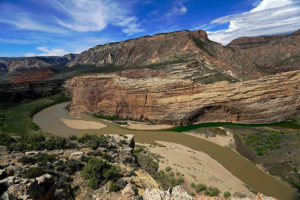Conservation Lessons from a Still-Wild River Be Known, Spread the Word, and Get Creative
 The confluence of the Green and Yampa Rivers in Dinosaur National Monument, Colorado.
The confluence of the Green and Yampa Rivers in Dinosaur National Monument, Colorado. I recently rafted a river that wouldn’t exist if not for a crucial conservation win back in the 1950s. The Yampa is the last major free-flowing river in the seven-state Colorado River Basin. It’s still wild because conservationists fought tooth and nail against its damming. Drifting along the river, gazing up at sheer canyon walls, I wondered: Could that old fight shed any light on today’s battles?
The Trump administration has waged a war on wild places and public lands, especially with the current review of twenty-seven of our 129 national monuments, with an eye to shrinking or eliminating them. The so-called public comment period (your chance to comment directly to the federal government) on the monument review ended July 10, but Interior Secretary Ryan Zinke has until late August to make his final recommendations. Whatever happens next, there will be more protests and challenges and plenty of opportunity for “public comment” that reach far beyond a form on a federal website.
That the Yampa ran through Dinosaur National Monument worked in its favor some sixty years ago. A leading journalist of the time, Tom Wallace, wrote to President Eisenhower in 1953, explaining that the approval of the Echo Park Dam “would establish the precedent that no national reserve should be considered of sufficient importance as to prevent its being exploited industrially.”
Sound familiar? If monuments now under review get “right-sized,” in the words of Zinke, watch that space. Chances are the excised areas will be sold off to those who want to mine, extract, log, or graze them. Some of these wild areas are so remote that few have ever seen them.
It’s certainly easier to remove protection from areas few people have heard of. In 1950 only fifty people had traveled the Yampa. The Sierra Club led a campaign to make the river more widely known. They lobbied Congress, ran ads, and brought people out to float on and fall in love with the river. A 1953 film follows a smiling group, ages four to seventy-seven, rafting the Yampa. The film closes with, “The decision lies with Congress—your Congress….Shall we let man undo this miracle?”
It was also important to get writers onboard. Articles and op-eds appeared in newspapers and magazines across the country. San Francisco Chronicle writer David Perlman floated the Yampa in the 1950s with the Sierra Club, writing about the trip and the proposed dam. Harper’s columnist Bernard deVoto wrote a scathing and widely read article about the Echo Park Dam controversy for the Saturday Evening Post titled, “Shall We Let Them Ruin Our National Parks?” In 1955, Wallace Stegner edited This Is Dinosaur: Echo Park Country and Its Magic Rivers; every member of Congress received a copy.
Writers are still on the job. In fact, these days we’re all writers when we take a stand: signing checks, emailing representatives, ranting on Facebook. And echoing Stegner’s compilation, last year every member of Congress received a copy of Red Rock Testimony, a celebration of endangered Bears Ears National Monument with stories by writers from Navajo Poet Laureate Luci Tapahonso to former Interior Secretary Bruce Babbitt.
The successful fight to save the Yampa River decades ago did have a downside. As conservationists fought to make the Yampa known, another awe-inspiring place—Glen Canyon—was still languishing in obscurity. It was flooded in 1963 to create Lake Powell. The Sierra Club’s David Brower was especially devastated. “Glen Canyon died, and I was partly responsible for its needless death,” he wrote in 1963 in The Place No One Knew. “Neither you nor I, nor anyone else, knew it well enough to insist that at all costs it should endure.”
But Brower’s regret made a potent cocktail when shaken with successful strategies from earlier fights. When other dams were proposed on the Colorado River, Brower and adman Howard Gossage created one of the most iconic conservation ads ever. In 1966 it ran full-page in the New York Times, with the headline, “Should We Also Flood the Sistine Chapel So Tourists Can Get Nearer The Ceiling?” It won prizes. Better still, it won converts.
And that’s what we need now: converts to the belief that these places are the natural equivalents of our great cultural treasures. Converts who will spread the word of their beauty and their importance.
